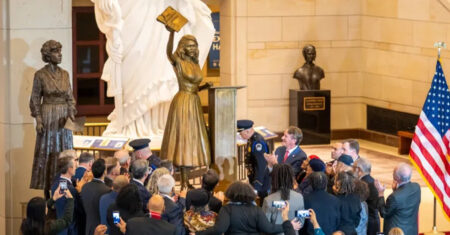The Transatlantic Slave Trade is not just Black history—it is American history, and Black Americans lived it. Their ancestors were violently torn from their homes, forced into brutal labor, and stripped of basic humanity. That legacy of injustice echoes loudly in every aspect of our society—because the slave trade wasn’t just cruel, it was foundational.
Yet today, that truth itself is under attack. President Donald Trump denounced the Smithsonian Institution as allegedly “out of control” for telling the unvarnished history of slavery—claiming museums focus too much on how bad slavery was and not enough on “brightness” or success, even as his administration reviews exhibits and threatens funding cuts to sanitize the narrative. He dismissed honest reflection as “woke,” arguing it undermines national pride.
We are re-running this series, which we originally published in 2019, each day because confronting our painful past is urgent—and because critics who erase suffering do so to keep oppression alive.
By Stacy M. Brown
Black Press USA Senior National Correspondent
“It started with slave ships… There are more records of slave ships than one would dream. It seems inconceivable until you reflect that for 200 years, ships sailed carrying cargo of slaves. How can man be nonviolent… in the face of the… violence that we’ve been experiencing for the past (500) years is actually doing our people a disservice; in fact, it’s a crime, it’s a crime.” — Public Enemy- “Can’t Truss It.” The transatlantic slave trade is often regarded as the first system of globalization and lasted from the 16th century through much of the 19th century. Slavery, and the global political, socio-economic, and banking systems that supported it, constitute one of the greatest tragedies in the history of humanity, both in terms of scale and duration.
The transatlantic slave trade was the largest mass deportation of humans in history and a determining factor in the world economy of the 18th century, where millions of Africans were torn from their homes, deported to the American continent, and sold as slaves, according to the United Nations Educational, Scientific and Cultural Organization – or UNESCO. The transatlantic slave trade that began about 500 years ago connected the economies of three continents, with Spain, Portugal, the Netherlands, England, and France acting as the primary trading countries.
“The transatlantic slave trade transformed the Americas,” wrote Dr. Alan Rice, a Reader in American Cultural Studies at the University of Central Lancashire in Preston, the United Kingdom. “Three factors combined to cause this transformation. Large amounts of land had been seized from Native Americans and were not being used,” Rice said. “Europeans were looking for somewhere to invest their money, and very cheap labor was available in the form of enslaved Africans; thus, the Americas became a booming new economy.” The transatlantic slave trade also formed an essential bridge between Europe’s New World and its Asia trade and, as such, it was a crucial element in the development of the global economy in the 18th century, Professor Robert Harms wrote for Yale University’s “Global Yale.”
Harms, a professor of History at Yale and chair of the Council on African Studies, continued: “There was one basic economic fact – little noticed by historians – that provides the key to the relationship between the direct trade and the circuit trade. “When a French ship arrived in the New World with a load of slaves to be bartered for sugar, the value of the slaves equaled about twice as much sugar as the ship could carry back to France. For that reason, the most common form of slave contract called for fifty percent of the sugar to be delivered immediately and the remainder to be delivered a year later. “The second delivery carried no interest penalty, and so the slave sellers were in effect giving the buyers an interest-free loan.”
In total, UNESCO estimates that between 25 and 30 million people — men, women, and children — were deported from their homes and sold as slaves in the different slave trading systems. More than half – 17 million – were deported and sold during the transatlantic slave trade, a figure that UNESCO historians said doesn’t include those who died aboard the ships and during the course of wars and raids connected to the slave trade. The trade proceeded in three steps. The ships left Western Europe for Africa loaded with goods that were to be exchanged for slaves. Upon their arrival in Africa, the captains traded their merchandise for captive slaves. Weapons and gunpowder were the most important commodities, but textiles, pearls, and other manufactured goods, as well as rum, were also in high demand.
The exchange could last from one week to several months. The second step was the crossing of the Atlantic. Africans were transported to America to be sold throughout the continent. The third step connected America to Europe. The slave traders brought back mostly agricultural products produced by the slaves. The main products were sugar, cotton, coffee, tobacco, and rice. The circuit lasted approximately eighteen months, and, to be able to transport the maximum number of slaves, the ship’s steerage was frequently removed, historians said. Many researchers are convinced that the slave trade had more to do with economics than racism. “Slavery was not born of racism; rather, racism was the consequence of slavery,” historian Eric Williams wrote in his study, “Capitalism & Slavery.”
“Unfree labor in the New World was brown, white, black, and yellow; Catholic, Protestant, and pagan. The origin of Negro slavery? The reason was economic, not racial; it had to do not with the color of the laborer, but the cheapness of the labor,” Williams said. Also, contrary to “the popular portrayal of African slaves as primitive, ignorant and stupid, the reality is that not only were Africans skilled laborers, they were also experts in tropical agriculture,” said editor and social media and communications expert, Michael Roberts. In a dissertation for op-ed news earlier this year, Roberts said, Africans were well-suited for plantation agriculture in the Caribbean and South America. Also, the high immunity of Africans to malaria and yellow fever, compared to white Europeans and the indigenous peoples of the Caribbean and South America, meant Africans were more suitable for tropical labor. “While Native Americans’ labor were initially used, Africans were the final solution to the acute labor problem in the New World,” Roberts said.
“The slave trade was one of the most important business enterprises of the 17th century. The undisputed fact is that the nation states of Europe stabilized themselves and developed their economies mainly at the expense of millions of Black African people,” he said. During the 16th Century, when Europeans first made regular contact, West Africa had highly developed civilizations, and Africans were keen to trade their gold, silver, copper, Ivory, and spices for European pots, pans, cloth, and guns. However, Europeans soon became more interested in exploiting the people of Africa and forcing them into slave labor. Most of the slaves were taken from the West coast, but some were kidnapped further inland from the interior.
“The biggest lesson to be learned from this dark and evil chapter in human history is that exploiting fellow humans for cheap labor never pays off in the long run,” said Pablo Solomon, an internationally recognized artist and designer who’s been featured in 29 books and in newspapers, magazines, television, radio, and film. “The acts of using fellow humans as beasts of burden to save a few bucks always end up costing more in the long run, both in real money and in societal decay,” Solomon said. “Any rationalization of misusing fellow humans is both evil and ignorant,” he said.
One aspect of the transatlantic slave trade that would greatly enhance its understanding is that the English began to enslave and export Irish persons to the Caribbean in the time of Oliver Cromwell, said Heather Miller, an educator and writer with expertise in the teaching of reading and writing, who holds graduate degrees from Harvard and MIT. Cromwell was known for his campaign in Ireland that centered on ethnic cleansing and the transportation of slave labor to Barbados.“Irish enslaved persons worked alongside African enslaved persons in the Caribbean,” Miller said. However, historians generally agree that the most cruel and exploitative people have been the Africans.
Up Next: The Economic Engine of the New Nation







